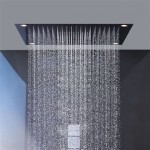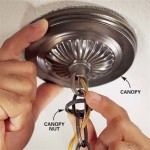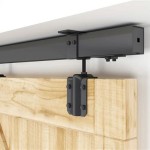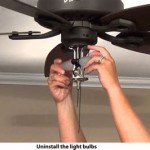Illuminating Your Sanctuary: LED Bathroom Ceiling Lighting Ideas
Bathrooms, often perceived as utilitarian spaces, are increasingly being recognized as personal sanctuaries. The right lighting plays a pivotal role in transforming a bathroom from a functional area into a relaxing and invigorating environment. LED bathroom ceiling lighting provides a versatile and energy-efficient solution for achieving optimal illumination and creating a desired ambiance. This article explores various LED bathroom ceiling lighting ideas, focusing on functionality, aesthetics, and practical considerations.
Understanding the Nuances of Bathroom Lighting
Before delving into specific LED lighting ideas, it is crucial to understand the key aspects of bathroom lighting. Achieving proper illumination in a bathroom requires a multi-layered approach, considering the specific tasks performed in the space and the overall aesthetic goal. Three essential layers of lighting commonly employed are ambient, task, and accent lighting. Ambient lighting provides general illumination for the entire room, while task lighting focuses on specific areas like the vanity or shower. Accent lighting adds depth and visual interest, highlighting architectural features or decorative elements.
Furthermore, safety is paramount in bathroom lighting. Due to the presence of water, all electrical fixtures must comply with relevant safety standards and be properly installed by a qualified electrician. Look for fixtures with Ingress Protection (IP) ratings suitable for wet environments. IP ratings indicate the level of protection against dust and water ingress. For bathroom lighting, a minimum IP44 rating is generally recommended for areas where water splashes are likely.
Color temperature is another crucial factor to consider. Measured in Kelvin (K), color temperature describes the warmth or coolness of the light emitted. Warmer temperatures (2700K-3000K) produce a yellowish light, creating a cozy and relaxing atmosphere. Cooler temperatures (4000K-5000K) emit a whiter, more energizing light, ideal for tasks like shaving or applying makeup. The choice of color temperature depends on the individual's preference and the intended function of the bathroom.
Exploring LED Ceiling Lighting Options for Bathrooms
LED technology offers a wide array of options for bathroom ceiling lighting, each with unique characteristics and benefits. Recessed lighting, also known as pot lights or can lights, is a popular choice for its sleek and unobtrusive design. Surface-mounted fixtures provide a more traditional aesthetic and are easier to install, as they do not require cutting into the ceiling. Pendant lights, typically suspended from the ceiling, can add a touch of elegance and serve as focal points. Linear LED fixtures offer a modern and minimalist look, providing uniform illumination across a larger area. Choosing the right type depends on the bathroom's size, style, and the desired lighting effect.
Recessed LED lighting is particularly well-suited for bathrooms with low ceilings, as it sits flush with the ceiling surface, maximizing headroom. These fixtures provide a clean and modern appearance and can be strategically placed to create even illumination throughout the room. Dimmable recessed LED lights offer added flexibility, allowing users to adjust the brightness according to their needs and preferences. The use of multiple recessed lights, strategically positioned, can eliminate shadows and create a well-lit and functional space.
Surface-mounted LED fixtures offer a wider range of styles and designs, from simple and functional to ornate and decorative. These fixtures are often easier to install than recessed lights, making them a suitable option for DIY projects. Surface-mounted LED fixtures can be combined with other lighting elements, such as vanity lights or sconces, to create a layered lighting scheme. They are also a good choice for bathrooms with limited ceiling space or where recessed lighting is not feasible.
Pendant LED lights are typically used for adding a touch of style and elegance to the bathroom. They can be hung above the vanity or bathtub to create a focal point and add visual interest. When selecting pendant lights for the bathroom, it is essential to choose fixtures that are moisture-resistant and appropriately sized for the space. The height of the pendant light should also be carefully considered to ensure it does not obstruct the view or create a safety hazard.
Linear LED fixtures are a modern and energy-efficient option for bathroom ceiling lighting. These fixtures provide uniform illumination and are ideal for larger bathrooms or areas where a minimalist aesthetic is desired. Linear LED fixtures can be surface-mounted, recessed, or suspended from the ceiling, offering versatility in design and installation. They are also available in a variety of lengths and widths, allowing for customization to suit specific bathroom dimensions.
Practical Considerations for Installing LED Bathroom Ceiling Lighting
Proper planning is essential before installing LED bathroom ceiling lighting. A well-thought-out lighting plan ensures that the right type and number of fixtures are selected and positioned to achieve the desired lighting effect. Consider the size and layout of the bathroom, the location of fixtures, and the overall aesthetic goal. It is also crucial to consult with a qualified electrician to ensure that the installation complies with all relevant safety codes and regulations.
When planning the lighting layout, consider the specific tasks performed in each area of the bathroom. Brighter, more focused light is needed for the vanity area, where tasks like shaving, applying makeup, and styling hair are performed. Softer, more diffused light is suitable for the shower or bathtub area, creating a relaxing and spa-like atmosphere. The use of dimmers allows for adjusting the brightness of the lights to suit different activities and moods.
Selecting the right LED bulbs is also an important consideration. LED bulbs are available in a variety of wattages, color temperatures, and light outputs. Choose bulbs that provide sufficient illumination for the intended purpose while also being energy-efficient. Look for bulbs with a high Color Rendering Index (CRI), which indicates the accuracy with which the bulb renders colors. A CRI of 80 or higher is generally recommended for bathrooms, ensuring that colors appear natural and true to life.
Finally, consider the maintenance requirements of the LED bathroom ceiling lighting. LED bulbs have a long lifespan, typically lasting for several years or even decades. However, it is still necessary to clean the fixtures regularly to remove dust and debris that can accumulate over time. Use a soft, damp cloth to wipe down the fixtures, and avoid using harsh chemicals or abrasive cleaners that could damage the finish.
Key Lighting Strategies for Different Bathroom Zones
Bathroom lighting can be greatly enhanced by tailoring the approach based on the specific zones within the space. The vanity area, toilet area, shower/bath area and general circulation space all require distinct lighting strategies.
Vanity Area Lighting
The vanity area is arguably the most critical area in the bathroom for proper lighting, as it is where tasks requiring precision and clarity are performed. The goal here is to eliminate shadows and provide even illumination across the face. While ceiling lights contribute, they should be complemented by dedicated vanity lighting, such as sconces mounted on either side of the mirror or a linear fixture above the mirror. The combination of ceiling-mounted LEDs and dedicated vanity lights creates a balanced and functional lighting scheme. Avoid overhead lighting alone, as it tends to cast unflattering shadows on the face. Color temperature in the 4000K-5000K range is ideal for the vanity area, providing a bright and energizing light that is suitable for detail-oriented tasks. Dimmable options can further enhance the functionality of vanity lighting, allowing for adjustment based on ambient light levels and personal preference.
Toilet Area Lighting
The toilet area generally requires less intense lighting compared to the vanity area. Ambient lighting from the ceiling is typically sufficient, but strategically placed accent lighting can add visual interest and create a more inviting atmosphere. A recessed LED light positioned above the toilet can provide adequate illumination. Consider incorporating a dimmer switch to allow for adjusting the brightness as needed. Avoid harsh, direct lighting in this area, as it can be uncomfortable and unflattering. Warmer color temperatures (2700K-3000K) are often preferred for the toilet area, creating a more relaxing and comfortable environment.
Shower and Bath Area Lighting
Safety is paramount in the shower and bath area, so choosing fixtures with appropriate IP ratings is crucial. Recessed LED lights with a minimum IP65 rating are recommended for this area, providing protection against water ingress. Consider using a dimmer switch to create a relaxing and spa-like atmosphere. Softer, more diffused lighting is generally preferred in the shower and bath area. Warmer color temperatures (2700K-3000K) can enhance the relaxing effect. Avoid placing lights directly above the showerhead, as this can cause glare and discomfort. Instead, position the lights to the side of the showerhead to provide even illumination without creating harsh shadows.
Selecting the Right LED Fixtures and Bulbs
The market offers a wide array of LED fixtures and bulbs. To make informed decisions, consider several key factors. First, verify the fixture's or bulb's Energy Star rating for efficiency. Energy Star certified products meet stringent energy-efficiency requirements, reducing energy consumption and saving money on utility bills. Second, evaluate the lumen output of the bulb, which measures brightness. The required lumen output depends on the size of the bathroom and the desired level of illumination. Third, assess the Color Rendering Index (CRI). A high CRI value ensures that colors appear natural and vibrant under the light. Fourth, determine the desired color temperature, as discussed previously. Warmer temperatures create a cozy ambiance, while cooler temperatures offer brighter task lighting. Finally, check the lifespan of the LED bulb or fixture. LEDs are known for their long lifespan, but it's essential to select products from reputable manufacturers to ensure quality and reliability.

20 Amazing Bathroom Lighting Ideas Architecture Design Ceiling Light

The 16 Best Bathroom Ceiling Lighting Ideas Lightopia

Led Ceiling Lights For Small Spaces Ideas Advice Lamps Plus

Helestra Oso Led Ceiling Light Spotlight 15 1553 07 Reuter

Bathroom Lighting Philips

Best Bathroom Lighting Ideas And Ceiling Lights For You Housing News

43 Creative Modern Bathroom Lights Ideas You Ll Love Digsdigs

Modern Porch Led Ceiling Lamp Bathroom Bedroom Hotel Lights Decor Black 24x20x12 5cm Com

Led Bathroom Lighting Idea Soft Strip Lights By Edge Design Modern

Modern Square Ceiling Light For Hallway Bathroom Kitchen Bedroom Garage Com
Related Posts








